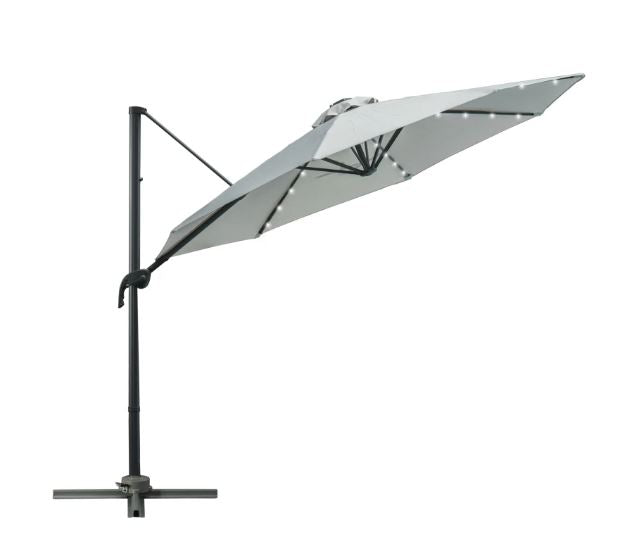Introduction
Selecting the right position for your garden parasol is crucial for creating a comfortable outdoor space.
Whether you opt for a cantilever or table-based parasol, understanding your needs and considering factors like sunlight exposure and outdoor layout can help you make an informed decision.
As a leading UK supplier of Parasols, we'll explore the different types, discuss the significance of sun positioning, provide location tips, and offer insights on maximising shade for the perfect outdoor experience.
Understanding Your Needs:
Before deciding on the type of parasol you need, it's essential to assess your specific requirements and the layout of your outdoor space. Here are some factors to consider:
- Mobility: Determine whether you prefer a parasol that can be easily moved to shade different areas of your garden or one that remains in a fixed position.
- Outdoor Layout: Take note of nearby trees, walls, and fences, as well as the size and shape of your outdoor area, to ensure the parasol fits appropriately.
- Functionality: Consider how you plan to use the parasol—whether it's for dining, lounging, or entertaining—to choose the most suitable type for your needs.
Key Takeaway: Choosing the right type of parasol depends on factors such as mobility, outdoor layout, and functionality, ensuring optimal shade and comfort in your garden space. 🌿
Types of Parasols:
- Table Parasol: Table parasols, offer versatility and convenience, making them a popular choice for outdoor dining areas. Here are some key features:
- Mobility: Table parasols can be easily moved and positioned through a table, providing shade for both guests and food.
- Affordability: They are typically more budget-friendly compared to cantilever parasols.
- Stability: While they offer mobility, the weighted base ensures stability, even on windy days.
Key Takeaway: Table parasols are ideal for shading dining areas and offer affordability and ease of mobility, making them a practical choice for various outdoor settings. ☀️

Example of the popular Red Parasol, supplied by Trade Warehouse
- Cantilever Parasols: Cantilever parasols provide focused shade in one fixed location, offering flexibility and functionality. Here's what you need to know:
- Flexibility: With an off-set post design, cantilever parasols can tilt and rotate to adjust to the sun's position throughout the day.
- Usable Shade: The off-set post design ensures maximum usable shade, making it suitable for lounging areas or poolside.
- Stability: While they can be moved if necessary, cantilever parasols are heavier and may require two people for repositioning.
Key Takeaway: Cantilever parasols offer flexibility and stability, making them an excellent choice for providing focused shade in specific outdoor areas, such as lounging spaces or poolside retreats. 🏖️

Grey Cantilever Parasol, supplied by Trade Warehouse
Sunlight and Shade Considerations
Understanding the movement of sunlight in your garden is essential for effectively positioning your parasol. Consider the following factors:
- Sun Direction: Determine whether your garden receives morning or afternoon sunlight and where the sun is positioned at different times of the day.
- Shade Preferences: Identify which areas of your outdoor space require the most shade, whether it's for morning coffee, midday relaxation, or evening gatherings.
- Tilt Functionality: Cantilever parasols with tilt functionality allow you to adjust the angle of the canopy to block out the sun's rays, providing customisable shade throughout the day.
Key Takeaway: By considering the direction of sunlight and your shade preferences, you can strategically position your parasol to maximize shade and create a comfortable outdoor environment for various activities. 🌅
Location Tips
- Grass: When placing a parasol on grass, ensure stability and prevent damage to the lawn with these tips:
- Even Ground: Choose a spot with even ground to ensure the parasol's stability and prevent it from toppling over.
- Movable: During sunny weather, periodically move the parasol to different spots to allow the grass underneath to recover.
- Clearance: Check for obstacles such as fences and trees to ensure the parasol canopy can open fully without obstruction.
Key Takeaway: When positioning a parasol on grass, prioritize stability, mobility, and clearance to prevent damage to the lawn and ensure optimal shade coverage. 🌱
- Patio: For patio dining and entertaining areas, consider the following tips for locating a parasol:
- Seat Coverage: Determine the number of seats you'd like to shade to select the appropriate size parasol canopy for your patio.
- Permanent Fixture: If you frequently dine or entertain outdoors, consider permanently locating a parasol on the patio for convenience and shade coverage.
Key Takeaway: Choosing a parasol for the patio involves assessing seat coverage and considering whether a permanent fixture would enhance outdoor dining and entertainment experiences. 🍹
- Pool-side: When positioning a parasol near a pool area, prioritize functionality and safety with these tips:
- Rotating Design: Opt for a rotating cantilever parasol to provide shade without obstructing the pool area, ensuring safety and convenience for swimmers.
- Reflection: Consider the reflection of sunlight off the water and choose a parasol that provides ample shade to prevent harmful UV exposure.
Key Takeaway: Selecting a rotating cantilever parasol for pool-side shading enhances safety and convenience, allowing swimmers to enjoy the water without compromising on sun protection. 🏊♂️
Maximising Shade
By carefully selecting the position of your garden parasol, you can create a comfortable outdoor oasis without constantly rearranging furniture. Whether you opt for a table or cantilever parasol, consider your specific needs, the layout of your outdoor space, and the movement of sunlight throughout the day to achieve optimal shade coverage.
Key Takeaway: Thoughtfully positioning your garden parasol maximizes shade and enhances outdoor comfort, allowing you to enjoy your outdoor space to the fullest. 🌳
Conclusion: Choosing the perfect position for your garden parasol involves understanding your needs, considering sunlight exposure, and selecting the appropriate location for optimal shade coverage. By following these tips and considering factors like mobility, stability, and functionality, you can create a comfortable outdoor environment where you can relax and unwind while being protected from the sun's rays.

